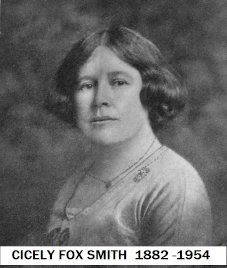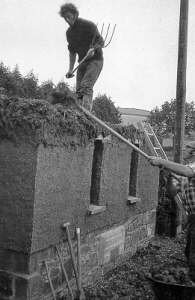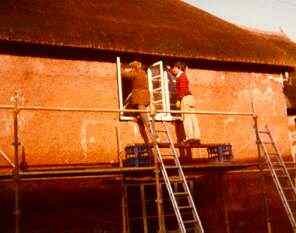Cob Building

Cicely Fox Smith
OLD cob wall
Have falled at last;
Us knawed he might
A good while past.
Great-grandad he
Built thicky wall
With maiden earth
And oaten straw.
He built en in
The good old way,
And there he’ve stood
Until to-day.
But wind and rain
And frost and snaw
Have all combined
To lay en law.

Cob Making In Devon
Us propped en up
With stones and ‘ood,
Us done our best,
But t’weren’t no good.
He gived a bit
And then a lot,
And at the finish
Down he squat.
And now, since barns
Has got to be,
Us’ll build another
‘Stead of he.
But not the same’s
He was afore,
‘Cos no one builds
Cob walls no more.
(Poem above by Cicely Fox Smith)

Cob Render
This material called cob, which was in general use in Devon and the surrounding counties for building all classes of houses (except large mansions), wherever the soil was suitable, is composed of earth and straw (barley-straw by preference) mixed together with water, like mortar, by being well beaten and trodden. The treading was usually done by men or boys, but occasionally by oxen and horses. The straw was sometimes chopped up, but more usually merely pulled apart and bruised with the hands. The earth nearest at hand was generally used, but it had to be a good heavy loam or clay-shillet, a light sandy soil being quite unsuitable for making cob. The method of building a cob wall is as follows: A good foundation of stonework is laid, carried usually to about one or two feet, but sometimes as high as five or six feet above the ground level; and the higher the stonework is carried, the better, as it elevates the cob-work from the moisture of the ground. Two men were usually employed in building a cob wall, the one standing by the heap of mixed earth and straw would lift it on to its place on the top of the stonework in clats or lumps with a pick or a dung fork; while the other man, standing on the wall would arrange it by treading it down into place. The older method, in use from mediæval times until about 1820, consisted in simply piling up the cob, leaving good edges on either side to be pared off afterwards with a spade, shovel, or cob-parer. After the wall was raised to a certain height, it was allowed some days, often weeks, to settle and dry, before more was laid on. The first course, or rise as it was generally termed, was about four feet in height, the next not so high, and so every succeeding rise was diminished in height as the work advanced. It was usual to pare down the sides of each successive rise before another was added to it. The walls built according to this method were very thick, often as much as 4 ft. and rarely less than 3 ft. in thickness, the outer surface being rough and often very uneven and out of the true.